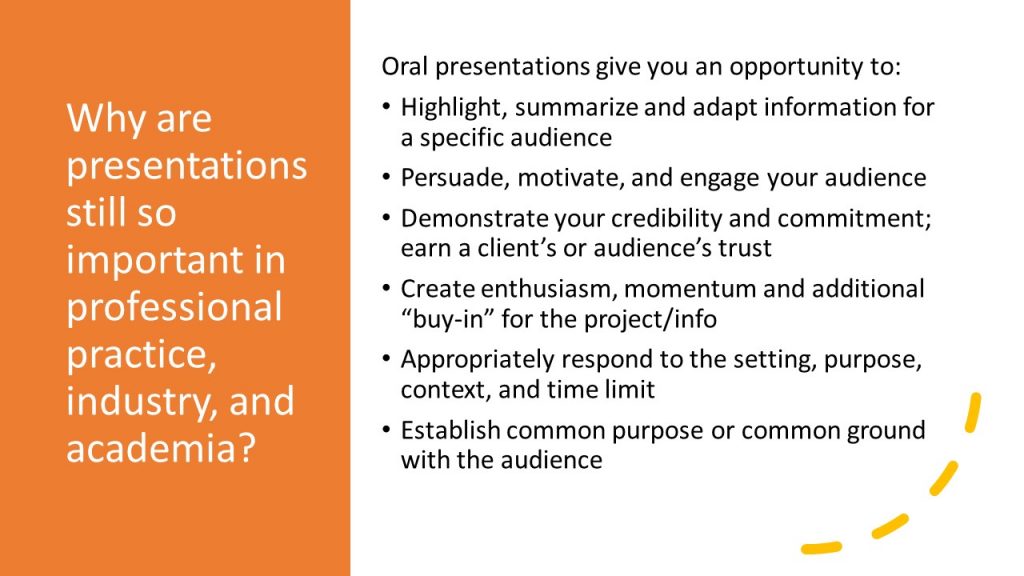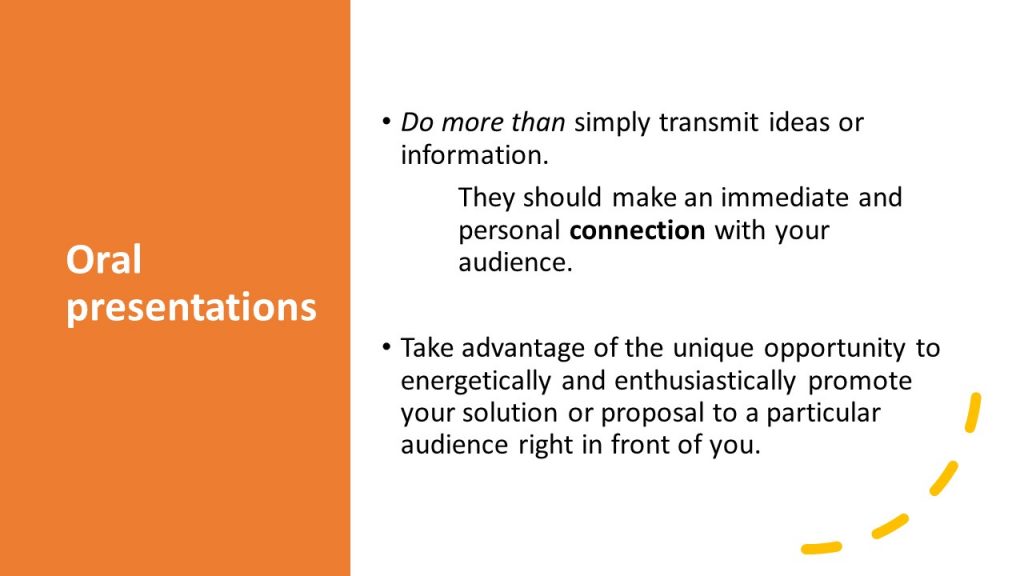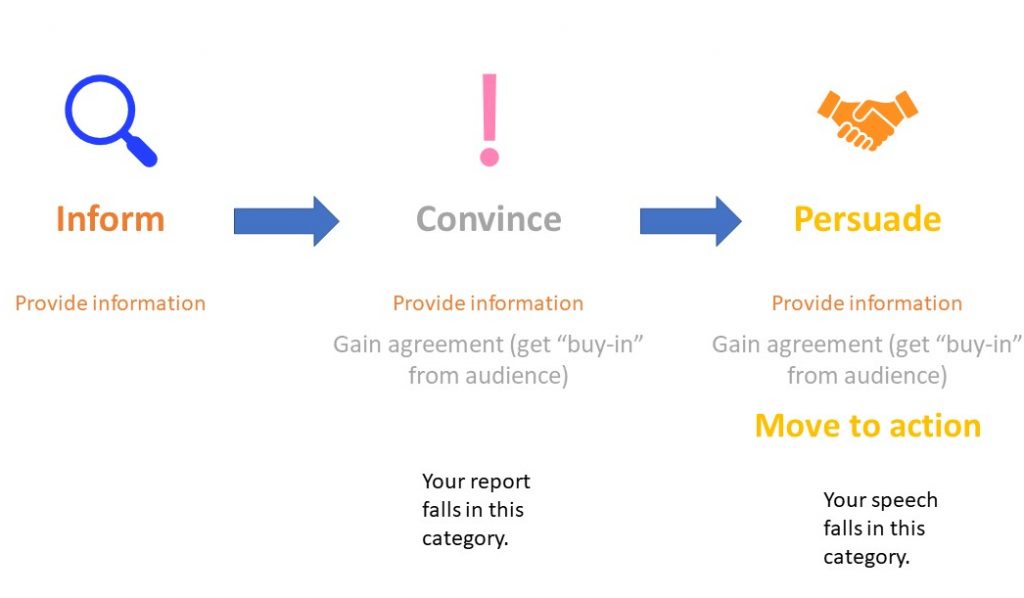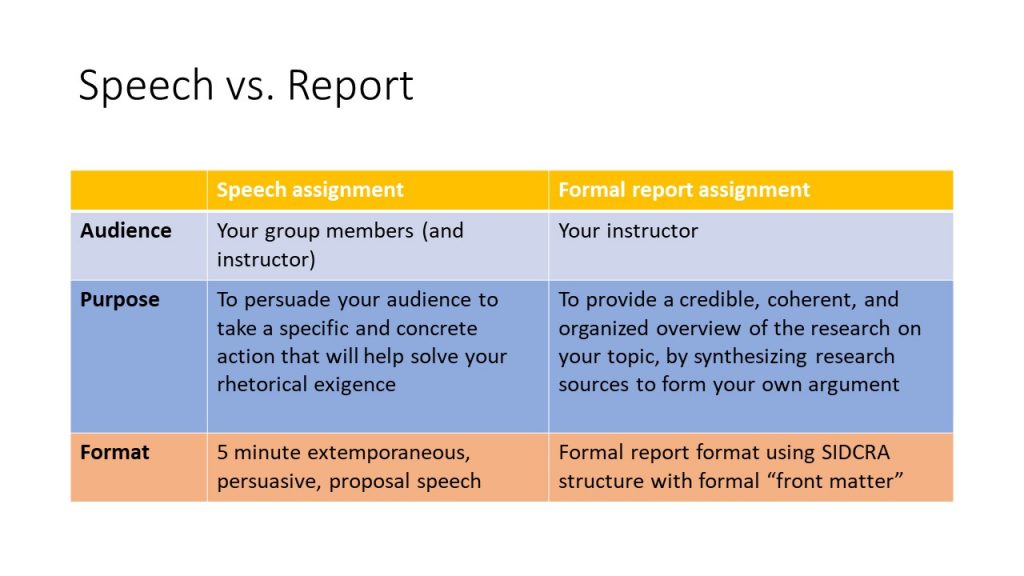Chapter 31: The Rhetorical Nature of Public Speaking
Learning Objectives
By the end of this chapter, you will be able to:
- Explain why presentations are important in professional practice
- Describe how the modes of appeal can impact your presentation and make it more persuasive
- Differentiate between your formal written report and your extemporaneous speech
Key Terms and Concepts
- extemporaneous speech
- modes of appeal
- ethos
- pathos
- logos
Public Speaking in the Technical Professions
As a professional, you will be making many speeches throughout your career, whether in meetings to coworkers and supervisors or in pitches to potential clients. You probably will not be surprised to see that there are many reasons why public speaking is such an important aspect of professional practice:

Do you notice what all of those bullet points have in common? Here’s a hint: the primary concern is not about the need to transmit information.
All of these points emphasize the importance of how we forge a relationship with our audience. In a professional context, this relational element is key. Of course we want to pass on information, but when we are giving speeches, we need to do so in a way that allows us to connect with our audience and make them care about or relate to our topic. The modes of appeal are one of the ways to do this.
A previous section of the textbook taught you about the Plan – Produce – Polish process of designing a formal research report. The next few chapters will walk you through the same Plan – Produce – Polish process, but this time for an extemporaneous speech that you will give to your classmates. In the following chapters, we look at how we can design and deliver presentations in order to engage our audience most effectively.
Your research report is meant to demonstrate your accomplishments in the use of written rhetoric; the 5-minute speech is now your chance to sharpen your oral rhetorical skills.
In summary:

The Modes of Appeal & Your Speech
How can rhetorical theory help you connect with your audience and make them care about your topic? Once again, we will use the three modes of appeal (ethos, pathos, and logos) to help answer that question. Aristotle considered these three modes the most important elements in a speaker’s arsenal. We will briefly review them now.
In this chapter you will also see the example we used earlier in the rhetoric and report writing chapter: Hamid’s speech on Lyme disease. Hamid’s example is here to serve as a reminder of how you might address the three modes of appeal when designing your own speech.
Ethos
Recall that ethos refers to the speaker’s character and expertise. When you use ethos correctly, you are showing the audience that you are credible and that they can believe what you say. To cover this element in your speech, tell the audience why they should listen to you. You can do this by demonstrating your authority on your topic.
For example, you could begin a persuasive speech on the dangers of drinking and driving with a short story about how you helped implement a “designated driver” program. This way the audience will understand your relationship to the message and form a positive perception of you. If you are trying to persuade the audience to donate blood, your credibility on the subject may come from your studies in the medical field or from having volunteered at a blood drive.
Hamid – Ethos
Hamid walks through three questions to determine his ethos.
- Does my content show awareness of the needs of the audience?
- In general, Hamid’s presentation is about personal health and safety. From his research, he knows that Lyme disease can have a serious, negative impact on people’s lives. In order to establish his credibility, he will need to show that concern through his tone, body language, and use of detail. He realizes that one way he can establish his credibility is by discussing his own close call with disease. This tactic will help him create a personal connection with his audience and help show why he thinks it is an important topic for them to be aware of.
- Am I meeting the conventions of the presentation?
- The main purpose of the presentation is to persuade the audience, but Hamid knows he will have to do more than persuade them that “Lyme Disease is a serious disease.” That is too easy, and the professor will probably say he didn’t go deep enough in his argument. That is why he will end his speech by discussing how his audience can take protective measures to stop themselves from catching the disease. If he can give them a list of actions to take, like checking for ticks when they go hiking, that will be much more persuasive.
- Is the information presented fair and complete?
- After thinking about his topic for some time, Hamid realizes he could easily use scare tactics to persuade his audience. He could do this by focusing only on the most severe consequences of Lyme Disease, like how it affects your central nervous system and can lead to paralysis. However, he also realizes that this is a pretty transparent tactic, and may turn his audience off his message. Instead, he decides to use a more balanced approach when describing the disease’s impact. By explaining the range of health effects the disease can have, he will show his audience that he has done his research (making him appear more credible), and allow them to come to the conclusion that the disease is serious on their own.
Pathos
As you may recall, the term pathos refers to the use of emotion as a persuasive element, in addition to how a speaker connects to the audience. You have probably seen commercials on television for charities trying to raise funds for sick children or mistreated animals, complete with sad images and music; this is pathos at work. We don’t always make decisions based only on clear thinking. We can be moved by words, by a video clip, or by a piece of music, which is also an effective way of persuading the audience to take a particular action.
Hamid – Pathos
Hamid walks through the three questions to determine his pathos. It should be easy, since he has already determined her audience’s needs by considering her rhetorical audience with Bitzer and how he will establish his credibility with ethos. Regardless, he still goes through the questions just to be sure.
- Does the quality of my research meet the expectations of the audience?
- Hamid is already planning to use his first-hand experience with Lyme Disease as his hook to get his audience’s attention. However, he doesn’t want to focus solely on personal experience. He knows his audience will want to hear data about how Lyme Disease is spreading in Canada. Since he already has information from the Center for Disease Control and Prevention, and several articles from medical journals, Hamid feels confident he will meet his audience’s expectations.
- Is the presentation designed to make it easy for the reader to understand?
- After reviewing some of his resources, Hamid starts to feel a little overwhelmed. Several of his sources, especially the ones from medical journals, have really detailed information about the disease and use terminology that he doesn’t fully understand. He could definitely get really detailed in his speech but then realizes he doesn’t have that kind of time. His speech is only 5 minutes long, after all. Also, if he doesn’t understand that level of detail, how will he be able to explain it to his nonexpert audience? Hamid decides to focus just on the most basic information like where the disease comes from, how it impacts the body, and how the audience can protect themselves against it.
- Are claims supported by credible evidence?
- All of Hamid’s evidence will come from reputable medical organizations and medical journals, so he’s good there. However, how will he show this evidence in his speech? Unlike a written report, there won’t be a list of references at the end for his audience to see. This means he will have to mention the names of his sources his in speech. For example, he might say “The Public Health Agency of Canada provides the criteria for diagnosing and treating Lyme Disease.” Mention the organizations or journals directly will help here. However, Hamid knows he’ll have a hard time keeping all those names straight, so he makes sure to write them down on his notecard so he doesn’t forget.
Logos
As we discussed earlier, the term logos refers to in part to your message’s logic. To win your audience over using logic, your speech must be carefully organized and present facts and evidence. Depending on the general purpose of your speech, particularly if its goal is to persuade, you may need to present an argument. To do this, logos is key. Think about what prosecutors do during a trial—particularly during closing arguments. This is the place for facts and reason. Prosecutors will argue that the scenario they have presented is the only logical interpretation of the evidence. To use logos effectively, incorporate expert testimony, statistics, and other reliable data, and order your points carefully.
Hamid – Logos
Hamid is almost done. He feels like his speech is really coming together. He goes through the final three questions to ensure his logos appeal is strong enough.
- Is the issue presented in a complete and balanced way?
- Obviously, nobody is going to say that Hamid should include an argument that is pro-Lyme Disease. That doesn’t make sense. What matters here is that Hamid is neither diminishing the severity of the disease or overstating its effects. He also needs to make sure that he will be providing his audience with just enough information so that are knowledgeable, but not overwhelmed by the content.
- Does the presentation organize sections in a logical way?
- After considering Bitzer’s constraints and using the speech outline provided by his instructor, Hamid feels he has a good structure for his speech. He knows he will open by briefly talking about his own close call with disease, then he will provide of an overview of the disease. He will follow this with explaining why testing for Lyme Disease is challenging, how the disease is spreading in Canada, and then provide his audience with a list of strategies for fighting the disease. It’s a lot to fit into five minutes, so Hamid is aware he will have to be very selective of what information he includes.
- Is the argument positioned to recognize the audience’s concerns?
- Hamid knows from personal experience that medical issues can be pretty daunting. He doesn’t want to scare his audience, and he also doesn’t want them to be self-defeated by the end of his presentation. That is why his speech will end with a list of strategies they can take to protect themselves from the disease. By including that content, he will empower his audience.
Exercise: The Modes of Appeal and Your Speech
As a review, watch the video below on how the modes of appeal can be used to plan your speech. Afterwards, answer the questions below:
- What specific ethos appeals will you use in your speech? How will these appeals establish your good will, good judgement, and good character?
- What specific logos appeals will you use to persuade your audience? What research do you need to do to have sufficient evidence to support your claims? What structure will be the most persuasive?
- What specific pathos appeals will you use to connect your audience to your topic and to the action? To what needs, values, and expectations of the audience will you appeal? What emotional appeals will you use?
How is your Speech Different from your Report?
Does all this sound familiar at all? It should, since we already made the same points (and used similar examples) about the modes of appeal when discussing your formal written report. Though the format and purpose is completely different, harnessing the same rhetorical concepts and implementing them in your speech will make you successful.
Below are two graphics that indicate how your speech's purpose is different from the formal report:


Key Takeaways
- You will give many oral presentations throughout your career. However, these presentations should do more than just transmit information. They should also connect with an audience and make them care about or relate to a topic.
- In this course, you will give an extemporaneous speech. While the format and structure of this speech will be different from your formal written report, you will still apply rhetorical theory (the modes of appeal) to make sure your speech is persuasive in nature.
Attributions
This chapter is adapted from “Professional Communications” by Olds College (on Open Library). It is licensed under Creative Commons Attribution 4.0 International License.
the receiver or receivers of a message
Aristotle's means for persuading an audience. The modes are ethos, pathos, and logos
an account of your investigation into a subject, presented in a written document or oral presentation that has conventional formatting
a type of speech delivery that is carefully planned and rehearsed, but uses minimal notes and is spoken in a conversational manner
a rhetorical appeal that addresses the values of an audience as well as establishes authorial credibility/character
a rhetorical appeal that tries to tap into the audience's emotions to get them to agree with a claim
a rhetorical appeal that requires the use of logic, careful structure, and objective evidence to appeal to the audience
the attitude of a communicator toward the message being delivered and/or the audience receiving the message
an audience that can take action to solve a problem and can be persuaded by the rhetor to take action
a report where you want the audience to accept the facts and you want them to change their thinking and actions

